Training your dog to use the toilet can be a convenient and hygienic solution for both you and your pet. By following a few simple steps, you can teach your dog to pee in the toilet, eliminating the need for outdoor potty breaks or messy indoor cleanup. With rewards and supervision, you can train your dog to target objects, jump onto the toilet, and eventually relieve themselves. There are various techniques, such as using a stool or a container to simulate the toilet, and providing treats and clicker reinforcement. Some owners have even taught their dogs to flush and put the seat down!
Key Takeaways:
- Teaching your dog to use the toilet can simplify house-training and improve hygiene in your home.
- Consistency, positive reinforcement, and a regular routine are key to successful dog toilet training.
- Introduce a litter box or container as a stepping stone to transition your dog from outdoor potty to the toilet.
- Gradually train your dog to jump onto the toilet seat and guide them to the correct position for relieving themselves.
- Establish a command for toilet use and maintain good hygiene practices throughout the training process.
The Benefits of Dog Toilet Training
Dog toilet training has numerous advantages that make it a worthwhile endeavor for dog owners. By teaching your dog to use the toilet, you can eliminate the need for regular outdoor potty breaks, which can be especially challenging for individuals with mobility issues or busy schedules. This training method also eliminates the mess and odor associated with indoor potty accidents, creating a cleaner and more hygienic living environment for both you and your pet.
One of the significant benefits of dog toilet training is its suitability for owners of large dogs. Picking up waste in the yard can be physically demanding and time-consuming, but training your pet to use the toilet can alleviate this challenge. By teaching your dog to relieve themselves in the toilet, you can easily flush away the waste, saving you from the hassle of cleaning up and maintaining a tidy outdoor space.
Furthermore, dog toilet training promotes better hygiene practices in your home. Regularly cleaning the toilet to remove any traces of urine or feces ensures a fresh and odor-free environment. Using pet-friendly cleaning products helps disinfect the toilet area, preventing the spread of bacteria and maintaining a healthy living space for both you and your dog.
Teaching your dog to use the toilet offers convenience, cleanliness, and improved hygiene in your home, making it a highly beneficial practice for dog owners.
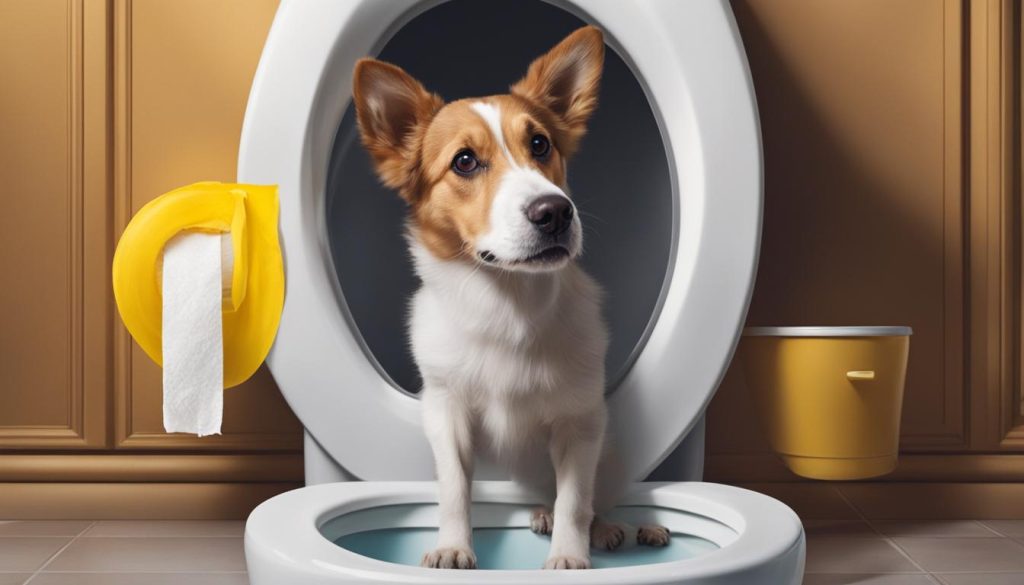
To sum it up, dog toilet training offers a range of benefits, including convenience, cleanliness, and improved hygiene. By eliminating the need for regular outdoor potty breaks and reducing indoor accidents, this training method simplifies house-training and makes daily life easier for dog owners. By following the steps outlined in this guide, you can successfully teach your dog to use the toilet and enjoy a cleaner, more hygienic living environment.
Establishing a Routine for Potty Training
Establishing a routine is crucial when it comes to successfully toilet training your dog. This is especially important for puppies, as it helps them learn when to eat, play, and go potty. Creating a regular schedule will make it easier for both you and your dog to stay consistent with the training process.
Take your puppy outside every two hours, as well as immediately after they wake up, play, and eat. This will help them associate going outside with relieving themselves. Choose a designated spot for them to go potty, and use a specific command to remind them what they should do. For example, saying “go potty” or “do your business” consistently will help your dog understand what is expected of them.
After your dog successfully eliminates outdoors, reward them with praise and treats immediately. This positive reinforcement will reinforce the desired behavior and let them know they have done a good job. Additionally, establishing a regular feeding schedule can help regulate their elimination times, making it easier for you to anticipate when they need to go potty.
Consistency is Key
Consistency is key when it comes to establishing a routine for potty training. Stick to the same schedule and commands every day, as this will help your dog understand what is expected of them. Make sure to take them out to their designated spot at the same times each day, and be patient as they learn. Try to reward them for their successes and remain consistent with your training methods.
By establishing a routine for potty training, you are setting your dog up for success. Through consistency and positive reinforcement, they will learn to associate going potty with the designated spot outside. This will make the overall toilet training process much smoother and easier for both you and your furry friend.
| Benefits of Establishing a Routine for Potty Training |
|---|
| Helps puppies learn when to eat, play, and go potty |
| Associates going outside with relieving themselves |
| Allows for consistent reinforcement of desired behavior |
| Regulates elimination times for easier anticipation |
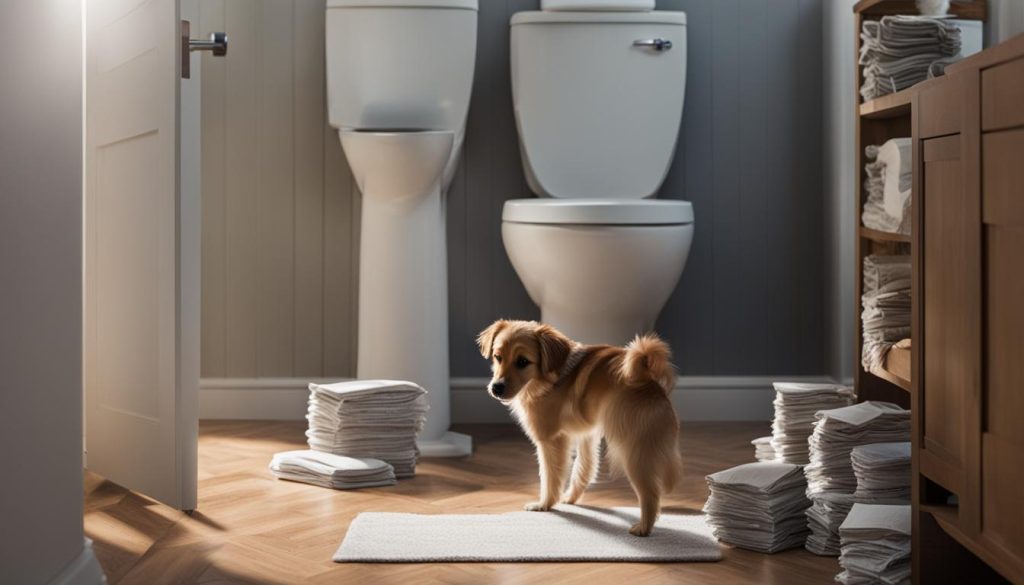
Using Positive Reinforcement for Toilet Training
Toilet training your dog requires consistent use of positive reinforcement techniques. By rewarding desired behaviors and using a clicker to reinforce good behavior consistently, you can effectively train your dog to use the toilet.
When your dog successfully eliminates in the desired spot, immediately reward them with praise and treats. This positive experience will help them associate going potty with positive consequences. Use a clicker to mark the desired behavior and reinforce it consistently.
Timing is crucial when using positive reinforcement. The reward should be given immediately after your dog successfully uses the toilet. This will help them understand which behavior is being reinforced and will encourage them to repeat it.
By incorporating positive reinforcement into your toilet training routine, you can motivate your dog to use the toilet consistently and create a positive association with the behavior.
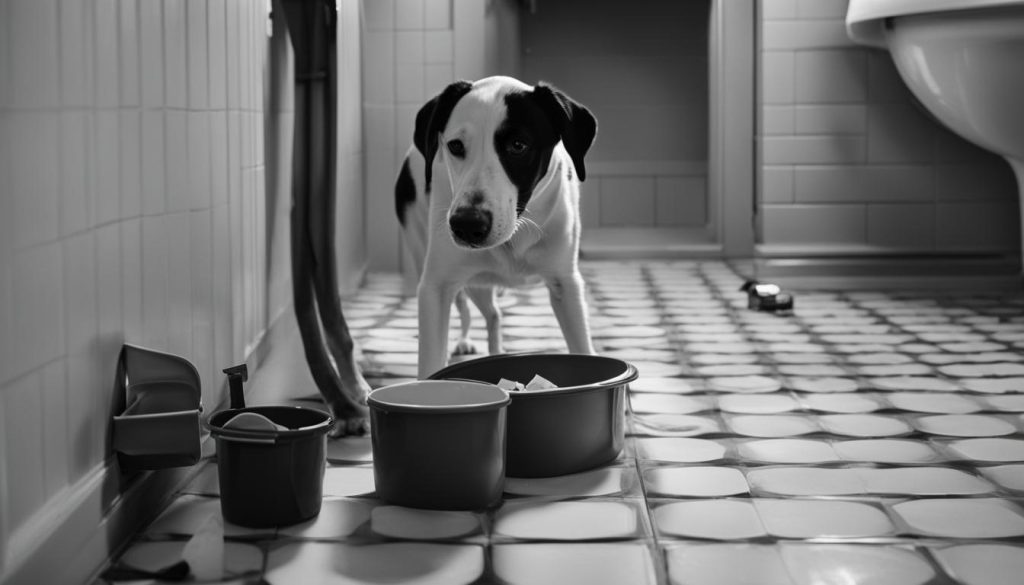
Benefits of Positive Reinforcement in Dog Toilet Training
“Positive reinforcement is a powerful tool in toilet training dogs. When we reward desired behaviors, we are not only teaching them what to do but also building a strong bond based on trust and mutual understanding.” – Dog Training Expert
Using positive reinforcement in dog toilet training has numerous benefits. It helps create a positive association with the behavior, making potty training a more enjoyable process for your dog. It also strengthens the relationship between you and your pet, promoting trust and cooperation.
Positive reinforcement allows you to effectively communicate with your dog, letting them know when they have done something right. By rewarding desired behaviors, you can motivate your dog to repeat the behavior and establish a consistent toilet training routine.
In contrast, punishment-based training methods can lead to fear and anxiety in dogs, hindering the learning process. Positive reinforcement not only achieves the desired results but also promotes a happy, confident, and well-trained dog.
Summary: Using positive reinforcement in dog toilet training is a highly effective and humane approach. By rewarding desired behaviors, you can motivate your dog to use the toilet consistently and create a positive association with the behavior. This method promotes trust, cooperation, and a stronger bond between you and your pet. Avoid punishment-based training methods, as they can lead to fear and anxiety in dogs.
Introducing a Litter Box or Container
To facilitate the transition from outdoor potty to the toilet, introducing a litter box or container can be a helpful step in your dog’s toilet training journey. This intermediate step allows your dog to associate the act of eliminating with a designated spot, preparing them for the eventual use of the toilet. Placing the litter box or container in a specific location will help your dog understand where they should go to relieve themselves.
Table: Comparison of Litter Box and Container Options
| Litter Box | Container |
|---|---|
| Smaller in size | Can be larger in size |
| Contains litter material | No need for litter material |
| May require more frequent cleaning | Easy to clean and maintain |
| Provides a designated spot with familiar scent | Offers stability and an easy transition to the toilet |
When choosing between a litter box and a container, consider the size of your dog and the available space in your home. A litter box is typically smaller and requires the use of litter material, which may need to be replaced and cleaned more frequently. On the other hand, a container can be larger in size, providing your dog with more space to eliminate comfortably.
Regardless of which option you choose, the objective is to create a designated spot for your dog to eliminate. This spot should have a familiar scent and be easily accessible for your dog. By using a litter box or container, you can help your dog develop the habit of targeting a specific area for elimination, bringing them one step closer to using the toilet.
Teaching Your Dog to Jump onto the Toilet Seat
Toilet training your dog is a step-by-step process that requires patience and consistency. Once your dog is comfortable using a stool or a child’s toilet seat as a wider perch, you can begin teaching them to jump onto the actual toilet seat. This skill is essential for them to successfully use the toilet.
Start by placing treats or a favorite toy on the toilet seat to entice your dog to jump up. Use a command such as “Up” or “Jump” to encourage them to leap onto the seat. Be sure to reward your dog with praise and treats when they successfully jump up. Repeat this exercise regularly, gradually increasing the distance from which your dog will jump onto the seat until they can do it confidently.
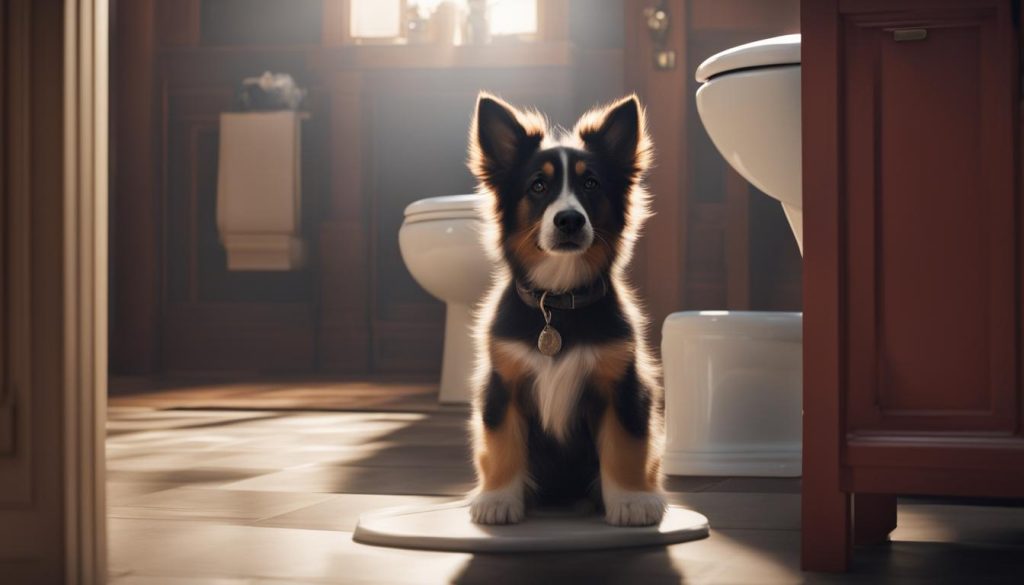
Using a Platform or Child’s Seat for Stability
If your dog is struggling with balance or confidence when jumping onto the toilet seat, you can provide additional stability by using a platform or a child’s seat. These options offer a wider surface area and more support, making it easier for your dog to balance. Gradually transition from the platform or child’s seat to the actual toilet seat as your dog becomes more comfortable and confident.
| Platform/Child’s Seat | Benefits |
|---|---|
| Provides stability | Helps build your dog’s confidence |
| Wider surface area | Easier for your dog to balance |
| Gradual transition to toilet seat | Ensures a smooth progression in toilet training |
Try to always provide positive reinforcement, patience, and encouragement during the training process. Each dog learns at their own pace, so be prepared for variations in progress. With consistent practice and reinforcement, your dog will eventually master the skill of jumping onto the toilet seat, bringing you one step closer to successful toilet training.
The Correct Position for Toilet Use
Once your dog is comfortable jumping onto the toilet seat, guide them to the correct position for relieving themselves. This step is crucial for successful dog toilet training. By following a few simple techniques, you can ensure that your dog understands how to properly use the toilet.
Using Visual Cues and Target Objects
One effective method to guide your dog to the correct position is by using visual cues and target objects. Start by placing a target object, such as a small mat or disc, on the inside edge of the toilet seat. This will help your dog understand where they should position themselves to eliminate. Encourage your dog to step onto the target and reward them with treats and praise when they do.
| Visual Cue | Instructions |
|---|---|
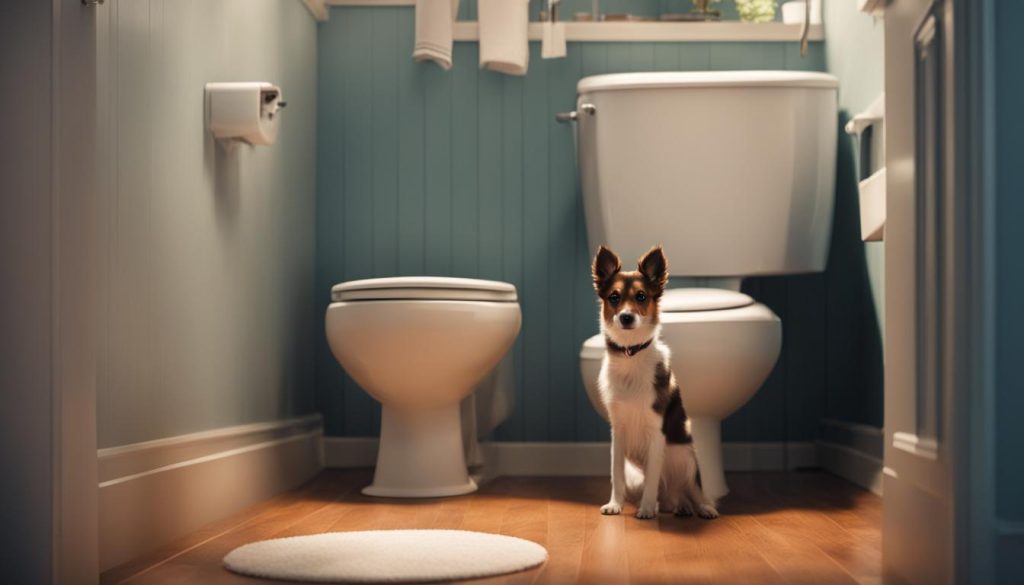 |
Place a target object, such as a small mat or disc, on the inside edge of the toilet seat. |
 |
Encourage your dog to step onto the target object and reward them with treats and praise. |
The Command for Correct Position
In addition to visual cues, introduce a command that signals your dog to assume the correct position for toilet use. Choose a simple, consistent command such as “Toilet” or “Potty.” Use this command every time you guide your dog to the correct position. With repetition and reinforcement, your dog will come to associate the command with the desired behavior.
Instruct your dog using the command and gently guide them onto the target object. Reward them with treats and praise when they assume the correct position. Consistency and positive reinforcement are key to success.
By using visual cues, target objects, and a specific command, you can effectively guide your dog to assume the correct position for toilet use. Consistency and positive reinforcement will help your dog understand and repeat the behavior. With patience and practice, your dog will master the art of using the toilet, creating a more convenient and hygienic environment for both of you.
Adding the Command for Toilet Use
As you progress with toilet training your dog, introduce a command that signals them to go potty. This command will help your dog understand what behavior is expected of them when using the toilet. Choose a specific word or phrase that you will consistently use during potty breaks.
When you take your dog to the designated toilet area, say the command firmly and clearly. For example, you can say “Go potty” or “Toilet time.” Be sure to use the command right before your dog eliminates, so they can associate the act with the command. This will help them understand what you expect them to do.
Once your dog successfully eliminates on command, provide immediate praise and rewards. This positive reinforcement will strengthen the association between the command and the desired behavior. Over time, with consistent use of the command, your dog will learn to perform the behavior on cue.
Troubleshooting and Tips for Success
Toilet training your dog can have its challenges, but with patience, consistency, and the right approach, you can achieve success. Here are some troubleshooting tips and additional advice to help you navigate the toilet training process:
Troubleshooting Common Issues
- If your dog is struggling with balancing on the toilet seat, consider using a more stable platform or stool as a stepping stone. This can help them feel more secure and build confidence.
- If accidents happen indoors, avoid punishment and instead focus on reinforcing the desired behavior. Clean up accidents promptly and use positive reinforcement when your dog successfully uses the toilet.
- Some dogs may require more time and repetition to grasp the concept of using the toilet. Be patient and consistent in your training efforts, and adapt your approach if needed.
Tips for Success
- Stick to a regular potty schedule and establish a consistent routine. Take your dog to the toilet area at the same times each day, such as after meals and waking up in the morning.
- Use positive reinforcement techniques to motivate your dog and make toilet training a positive experience. Reward them with praise, treats, and verbal cues when they successfully use the toilet.
- Maintain a calm and encouraging environment during toilet training sessions. Avoid distractions and create a comfortable space for your dog to focus on the task at hand.
By following these troubleshooting tips and implementing the provided advice, you can overcome common challenges and increase your chances of success in toilet training your dog. Try to be patient, consistent, and positive throughout the process, and celebrate each milestone your dog achieves on their way to becoming a toilet-trained pet.
Please refer to the table below for a summary of troubleshooting tips and tips for success in dog toilet training:

| Troubleshooting Tips | Tips for Success |
|---|---|
| Use a stable platform or stool to help your dog balance on the toilet seat | Stick to a regular potty schedule and establish a consistent routine |
| Avoid punishment for accidents and focus on reinforcing the desired behavior | Use positive reinforcement techniques to motivate your dog |
| Be patient and adapt your approach if needed | Create a calm and encouraging environment during training sessions |
Maintaining Good Hygiene
To ensure a clean and healthy environment while toilet training your dog, it is essential to establish good hygiene practices. By following these tips, you can maintain a hygienic space for both you and your pet.
Cleaning the Toilet
Regularly clean the toilet to remove any traces of urine or feces. Use pet-friendly cleaning products that are safe for your dog and effective in eliminating odors. Disinfect the toilet area thoroughly to prevent the spread of bacteria and maintain a clean environment.
Hand Hygiene
After each toilet training session, wash your hands thoroughly with soap and water to prevent the transmission of germs and bacteria. This practice is crucial for maintaining personal hygiene and protecting yourself and your household members from potential health risks.
Preventing Contamination
Take steps to prevent cross-contamination between the toilet and other areas of your home. Avoid allowing your dog to roam freely in areas where food is prepared or consumed. Keep the toilet training area separate from your living space to minimize the risk of spreading germs.
Final Thoughts
Maintaining good hygiene is an important aspect of toilet training your dog. By cleaning the toilet regularly, practicing proper hand hygiene, and preventing contamination, you can create a clean and healthy environment for both you and your pet.
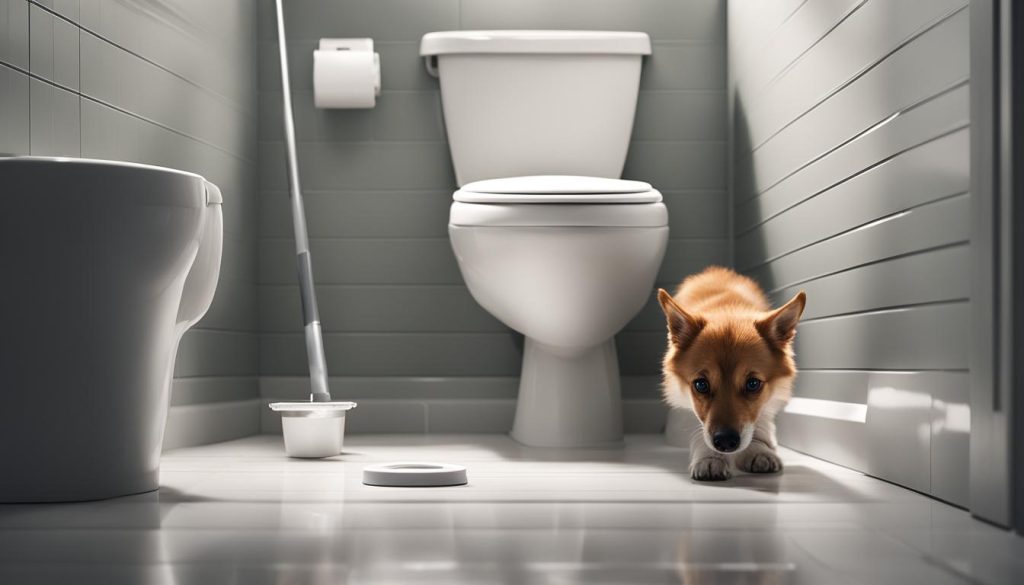
Consistency and Reinforcement for Long-Term Success
Consistency and reinforcement are crucial when it comes to achieving long-term success with dog toilet training. By staying consistent in your training methods and reinforcing desired behaviors, you can ensure that your dog continues to use the toilet consistently. Here are some key tips for maintaining consistency and reinforcement:
- Stick to a regular schedule: Establish a routine for potty breaks and adhere to it consistently. Take your dog outside to the designated toilet area at the same times each day, including after meals, playtime, and waking up.
- Use positive reinforcement: Reward your dog immediately with praise, treats, or a clicker when they successfully use the toilet. This positive reinforcement will help them associate the behavior with a positive outcome, encouraging them to repeat it.
- Continue training even after success: Even after your dog has mastered using the toilet, reinforce the behavior. Don’t assume that once they’ve learned, they will never have accidents again. Keep providing rewards and praise to maintain the habit.
- Maintain a consistent routine: Dogs thrive on routine, so stick to the established schedule for potty breaks. This will help solidify the training and make it easier for your dog to understand and follow the routine.
By following these tips and remaining consistent in your training efforts, you’ll set your dog up for long-term success with using the toilet. To put it simply, patience and positive reinforcement are key, so be sure to celebrate each small victory along the way.
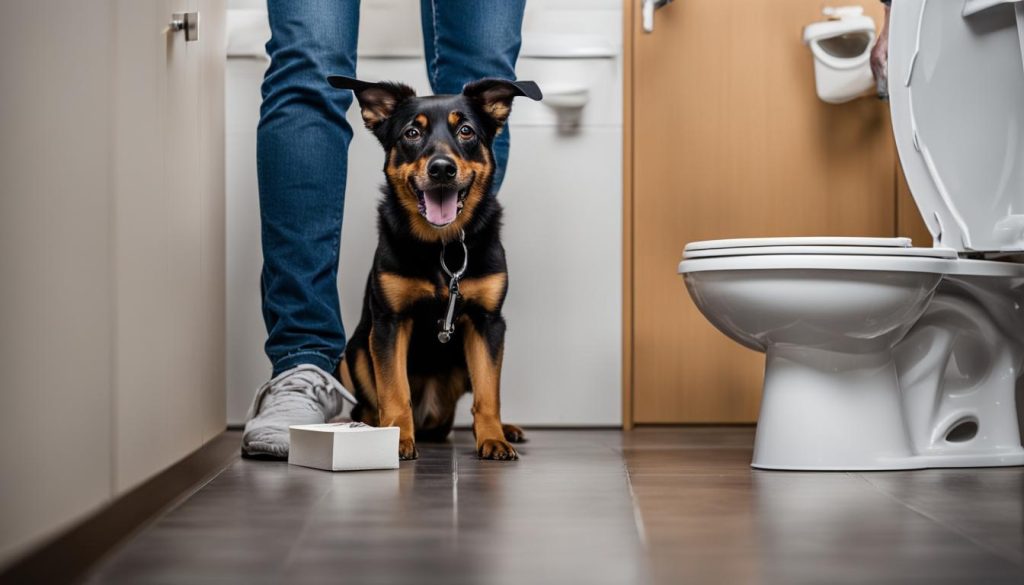
Additional Tips for Long-Term Success
In addition to consistency and reinforcement, there are a few extra tips that can help ensure long-term success with dog toilet training:
- Supervise your dog: Especially during the early stages of training, closely supervise your dog when they’re using the toilet. This will allow you to redirect any accidents and provide immediate reinforcement for desired behavior.
- Be patient: Toilet training takes time and patience, so remain calm and understanding throughout the process. Avoid punishment or frustration, as this can hinder progress and cause setbacks.
- Be prepared for accidents: Accidents happen, especially during the initial stages of training. Instead of getting discouraged, use accidents as opportunities to reinforce the desired behavior and make any necessary adjustments to the training routine.
By implementing these additional tips alongside consistency and reinforcement, you’ll increase the likelihood of long-term success in teaching your dog to use the toilet.
Final Thoughts
Toilet training your dog can be a valuable skill that simplifies your house-training routine and improves hygiene in your home. By following the steps outlined in this guide, you can successfully teach your dog to pee in the toilet. With patience, consistency, and positive reinforcement, your furry friend can learn to target objects, jump onto the toilet seat, and relieve themselves.
To put it simply, establishing a routine is crucial for successful toilet training. Consistency and reinforcement are key, even after your dog has mastered using the toilet. By maintaining a regular schedule for potty breaks and adhering to the established routine, you can ensure that your dog continues to use the toilet consistently, leading to a happier home and a healthier dog.
Good hygiene practices are also important throughout the training process. Regularly clean the toilet area to remove any traces of urine or feces, and use pet-friendly cleaning products to disinfect and eliminate odors. Additionally, wash your hands thoroughly after each toilet training session to prevent the spread of bacteria and maintain a clean and healthy environment for both you and your dog.
Overall, teaching your dog to use the toilet is a rewarding endeavor that can bring convenience and hygienic benefits to both you and your pet. By following the techniques and tips mentioned in this guide, you can successfully toilet train your dog, creating a happier home and a healthier dog.
FAQ
Why should I toilet train my dog?
Toilet training your dog can be a convenient and hygienic solution for both you and your pet. It eliminates the need for regular outdoor potty breaks and reduces the mess and odor associated with indoor accidents.
How do I establish a routine for potty training?
Establishing a routine is crucial for successful toilet training. Take your dog outside every two hours and immediately after waking up, playing, and eating. Choose a designated spot and use a specific command to remind your dog what to do. Reward them with praise and treats after they eliminate outdoors.
What is the best method for toilet training dogs?
Positive reinforcement is an effective method for toilet training dogs. Reward your dog with praise and treats when they successfully eliminate in the desired spot. Use a clicker to mark and reinforce the behavior consistently.
How can I teach my dog to jump onto the toilet seat?
Start by using a stool or a child’s toilet seat to provide a wider perch for your dog during training. Use treats and positive reinforcement to encourage them to jump up and balance on the seat. Gradually build up their confidence and comfort with jumping onto the toilet seat.
How do I guide my dog to the correct position for relieving themselves?
Use treats and a command to prompt your dog to position themselves over the toilet. You can also use visual cues such as target objects to help them understand the desired position. Consistency, rewards, and positive reinforcement will help your dog learn the correct posture for using the toilet.
How do I add a command for toilet use?
Start by associating a specific word or phrase with the act of eliminating and use it consistently during potty breaks. When your dog successfully toilets on command, provide immediate praise and rewards. Over time, they will learn to associate the command with using the toilet.
What should I do if my dog is struggling with toilet training?
If your dog is struggling, consider using a more stable platform or stool to help them balance on the toilet seat. Avoid punishment and focus on reinforcing the desired behavior. Maintain a consistent routine and provide regular potty breaks to support their progress.
How do I maintain good hygiene during dog toilet training?
Clean the toilet regularly to remove any traces of urine or feces. Use pet-friendly cleaning products to disinfect the toilet area and eliminate odors. Wash your hands thoroughly after each toilet training session to prevent the spread of bacteria.
How can I achieve long-term success with dog toilet training?
Consistency and reinforcement are key. Continue to reinforce desired behaviors with rewards and positive reinforcement even after your dog has mastered using the toilet. Maintain a consistent schedule for potty breaks and adhere to the established routine for long-term success.






